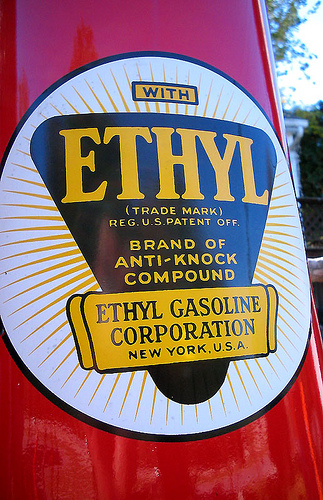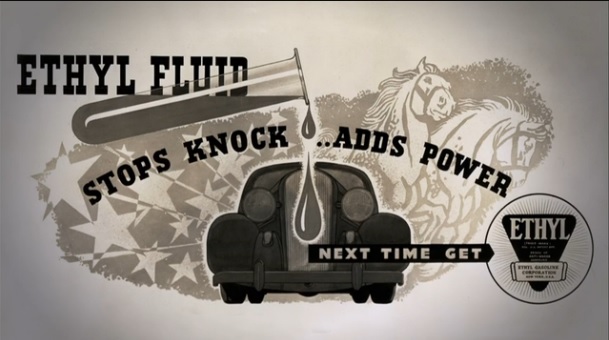Today when you go to fill your gas tank, frequently the pump will have some of the gasoline grades labeled "unleaded" or "unleaded plus". People old enough to remember the 1970s will remember that gasoline contained lead before it was phased out and permanently banned in the 1980s. Lead is one of the most poisonous substances known to man. Exposure to lead can cause damage to the nervous system, memory loss, kidney damage, and many other problems, and lead has been known to be poisonous for thousands of years. Despite its toxicity, lead was added to gasoline for over 50 years, as the lead additive helped prevent engine knock and brought better engine performance. As a result, everyone was exposed to lead through car exhaust. Factory workers were particularly vulnerable to lead poisoning and many died because of it. How is it that a known poison was allowed to be added to gasoline for so many years? What finally brought about the phase out of leaded gasoline?
As early as 400 BC there are writings from Greek physician and philosopher Hippocrates that describe symptoms of lead poisoning. In the 1700s, workers who mined lead were described as having demons and ghosts. In 1910 researcher Alice Hamilton did a study which found extensive poisoning of workers in the lead industry. Meanwhile around the same time, the upstart auto industry was facing problems of poor quality gasoline, poor engine performance and engine knock. Engine knock occurs when the fuel is not burned evenly inside the engine, which causes interference in the engine's cycles. It results in a "knocking" or "pinging" noise but also causes damage to the engine. Before 1920 a number of gasoline additives were tried, but in 1921 General Motors researcher Thomas Midgley discovered a substance called tetraethyl lead (TEL) was very effective in reducing engine knock. The additive was branded "ethyl" which de-emphasized the "lead" part of it as lead was known to be poisonous.
Researchers including Midgley had worked with other additives such as ethyl alcohol that showed potential for reducing engine knock, but in the highly competitive auto industry tetraethyl lead won out. Standard Oil and General Motors formed a joint corporation called the Ethyl Corporation and pushed hard to get TEL into production. In 1923 during initial production of TEL, a number of workers died of lead poisoning but these deaths were kept relatively quiet. The Ethyl Corporation stood to make a huge profit if TEL became the standard additive as 6 billion gallons of gasoline were sold each year. As production ramped up in a refinery in Bayway, New Jersey, workers at the Bayway plant showed symptoms of going insane, and 6 of them died. The deaths were picked up by the press this time, and this caused a huge problem for the Ethyl Corporation. The plant in Bayway became known as the "looney gas building." The Ethyl Corporation then pulled together a news conference with Thomas Midgley, who washed his hands in leaded gasoline to prove how safe it was. Despite assurances from Ethyl Corporation, the authorities in New Jersey were unimpressed, and ordered the plant to be shut down.
New York City medical examiner Charles Norris and toxicologist Alexander Gettler examined the bodies of the men in the New Jersey factory to determine if the cause was lead poisoning. They found through pioneering work that the lead was both absorbed through the skin and inhaled. The research found the men who died had an astonishing amount of lead in the bodies. When the research was made public, authorities banned leaded gasoline in New York City, New Jersey, and Philadelphia. The Ethyl Corporation, seeing its massive profits slipping away, went to President Calvin Coolidge and pushed for an "independent" evaluation. Coolidge appointed a panel of "experts" which consisted of all industry scientists, and the panel reported its findings in January 1926. It recommended gloves and masks for workers in the factory, but concluded that the public was safe and dismissed Norris' request for a ban. During the inquiry, scientists discussed alternatives to TEL as additives to gasoline, but the Ethyl Corporation insists that there are none. The Federal government lifted all restrictions on sale of leaded gas, and eventually lead was added to 90% of the gasoline sold. Inventor Thomas Midgley had to take a leave of absence from work to recover from - lead poisoning.
For the next 40 or so years, leaded gasoline was the standard used in automobiles, despite health concerns for the workers in the gasoline plants and despite health concerns about lead exposure for the public through car exhaust. The Ethyl Corporation with the huge muscle of Standard Oil and General Motors behind it, squashed any safety concerns and any company who proposed an alternative even though it was known that other additives were just as effective at eliminating engine knock.
Finally, in 1966 the US Senate held hearings on leaded gasoline where scientists showed evidence that even a small exposure to lead could be toxic. Meanwhile, the Federal government started to force the auto-makers to install anti-pollution devices called catalytic converters. It turns out that the main element in catalytic converters was platinum which would be deactivated by lead, so unleaded gasoline had to be used once cars had the anti-pollution devices. The auto makers and the Ethyl Corporation fought hard against the government's planned phase-out of leaded gasoline, continually claiming that lead was not a danger to the public. In the end, leaded gasoline was phased out but it took the introduction of catalytic converters to trigger the phase-out, despite the well known poisonous attribute of lead itself.
Despite bans on leaded gasoline in the US and almost all other developed nations, leaded gasoline is still used in many 3rd world countries.








SUBMIT A COMMENT